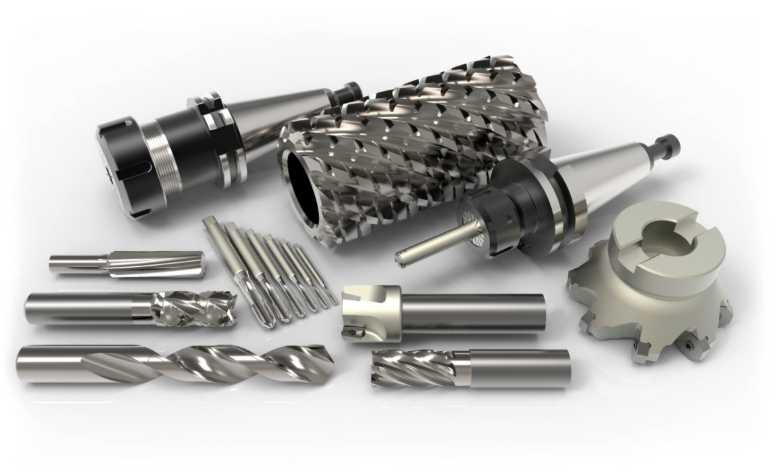
CNC Machining Cutting Tools
The combination of advanced CNC machining equipment and high-performance cutting tools are critical for high efficiency and good economic benefits. With the rapid development of tool materials, the physical, mechanical properties and cutting performance of new CNC cutting tools have been greatly improved. What materials are often used to make different tools and which one is the best? Here we introduce common types of cutting tools in CNC parts production and provide some tips for how to select the best cutting tool.
Types of CNC Cutting Tools – Different Materials of Cutting Tools and Their Advantages and Uses
According to the materials, the cutting tool can be divided into the following categories.
1. Diamond tools
Diamond cutting tools have high hardness, high wear resistance, and high thermal conductivity. They are mostly used for fine cutting and boring of non-ferrous and non-metallic materials at high speed. Suitable for processing all kinds of wear-resistant non-metal, such as glass fiber reinforced plastic powder metallurgy blank, ceramic materials, etc.; all kinds of wear-resistant non-ferrous metals, such as all kinds of silicon aluminum alloy; all kinds of non-ferrous metal finishing. Especially in the high-speed machining of aluminum and silicon aluminum alloy, diamond tools are the main cutting tools that are difficult to replace. Diamond cutting tools with high efficiency, high stability, and long life are indispensable tools in modern NC machining. Diamond tools include natural diamond tools, PCD diamond tools and CVD diamond tools
Advantages of diamond tools:
– Extremely high hardness and wear resistance
– Very low friction coefficient
– The cutting edge is very sharp
– High thermal conductivity
– Low coefficient of thermal expansion
Disadvantages of diamond tools:
The disadvantage of diamond tools is that they have poor thermal stability. When the cutting temperature exceeds 700 ℃~ 800 ℃, they will lose their hardness completely. In addition, they are not suitable for cutting ferrous metals, because diamond (carbon) is easy to interact with iron atoms at high temperature, so that carbon atoms are transformed into graphite structure, and the tools are easy to be damaged.
2. CBN (Cubic boron nitride) tools
Cubic boron nitride (CBN), second only to diamond in hardness and thermal conductivity, has excellent thermal stability and does not oxidize when heated to 10000 ℃ in the atmosphere. CBN has very stable chemical properties for ferrous metals and can be widely used in the processing of iron and steel products. CBN is suitable for finishing various hard cutting materials such as quenched steel, hard cast iron, high-temperature alloy, hard alloy and surface spraying material. The machining accuracy can reach IT5 (hole is IT6), and the surface roughness can be as small as ra1.25 ~ 0.20 μ M. CBN is a non-existent substance in nature, which can be divided into a single crystal and polycrystal, namely CBN and PCBN (polycrystal cubic boron nitride). CBN is one of the isomers of boron nitride (BN), and its structure is similar to that of the diamond. PCBN (polycrystalline cubic boron nitride) is a kind of polycrystalline material that can sinter fine CBN materials together by bonding phases under high temperature and high pressure. It is a kind of tool material whose hardness is only inferior to that of the diamond. It is called super hard tool material together with diamond. PCBN is mainly used to make tools or other tools.
Advantages of CBN tools
– High hardness and wear resistance
– High thermal stability
– Excellent chemical stability
– Good thermal conductivity
– Low friction coefficient
Disadvantages of CBN tools
The toughness and bending strength of CBN tool material are poor. Therefore, CBN turning tool is not suitable for rough machining with low speed and high impact load, and it is not suitable for cutting materials with high plasticity (such as aluminum alloy, copper alloy, nickel base alloy, steel with high plasticity, etc.), because serious chip build-up will occur when cutting these metals, which will worsen the processing surface.
3. Ceramic tools
Ceramic cutting tool plays a very important role in CNC machining, and has become one of the main tools for high-speed cutting and machining difficult materials. Ceramic cutting tools are widely used in high-speed cutting, dry cutting, hard cutting, and machining of difficult to machine materials. Ceramic cutting tools are suitable for cutting all kinds of cast iron (gray cast iron, nodular cast iron, malleable cast iron, chilled cast iron, high alloy wear-resistant cast iron) and steel (carbon structural steel, alloy structural steel, high strength steel, high manganese steel, quenched steel, etc.), as well as copper alloy, graphite, engineering plastics, and composite materials. Ceramic cutting tools can efficiently process high hard materials that can not be processed by traditional cutting tools; the optimal cutting speed of ceramic cutting tools can be 2-10 times higher than that of cemented carbide cutting tools, thus greatly improving the cutting efficiency; the main raw materials used for ceramic cutting tools are the most abundant elements in the earth’s crust. Therefore, the promotion and application of ceramic cutting tools can improve productivity and reduce processing costs Saving strategic precious metals is of great significance and will greatly promote the progress of cutting technology. Ceramic tool materials can be generally divided into three categories: alumina-based ceramics, silicon nitride-based ceramics, and composite silicon nitride alumina-based ceramics. Among them, alumina-based and silicon nitride-based ceramic tool materials are most widely used. The properties of silicon nitride-based ceramics are better than that of alumina-based ceramics.
Advantages of ceramic tools:
– High hardness and good wear resistance
– Not easy to bond with the metal
– High-temperature resistance, good heat resistance
– Good chemical stability
– Low friction coefficient
Disadvantages of ceramic tools:
The ceramic tool material has the problems of low bending strength and poor impact toughness, so it is not suitable for cutting at low speed and impact load.
4. Coated tool
Coating tool is one of the important ways to improve the performance of cutting tools. The appearance of coated tools makes a great breakthrough in cutting performance. Coated tools are coated with one or more layers of the refractory compound with good wear resistance on the tool body with good toughness. It combines the tool substrate with a hard coating, so that the performance of the tool is greatly improved. Coated tools can improve machining efficiency, improve machining accuracy, prolong tool life and reduce machining cost. About 80% of the cutting tools used in the new CNC machine tools are coated tools. The coated tool will be the most important tool in the field of CNC machining in the future. According to different coating methods, coated tools can be divided into chemical vapor deposition (CVD) coated tools and physical vapor deposition (PVD) coated tools. According to the different substrate materials of coated tools, coated tools can be divided into cemented carbide coated tools, high-speed steel coated tools, and coated tools on ceramics and super hard materials (diamond and cubic boron nitride).
Advantages of coated tools:
– Good mechanical and cutting performance
– Hight versatility
Disadvantages of coated tools:
With the increase of the coating thickness, the tool life will also increase, but when the coating thickness reaches saturation, the tool life will not increase significantly. When the coating is too thick, it is easy to cause peeling; when the coating is too thin, the wear resistance is poor. The coated blade has poor regrinding performance, complex coating equipment, high process requirements and long coating time.
5. High speed steel tool
High-speed steel (HSS) is a kind of high alloy tool steel with more alloying elements. High-speed steel tools have excellent comprehensive performance in strength, toughness, and process ability. High-speed steel still plays a major role in complex tools, especially in manufacturing hole cutting tools, milling tools, thread cutting tools, broaches, gear cutting tools, and other complex edge cutting tools. High-speed steel tools are easy to grind out sharp cutting edges.
How to Choose the Right CNC Cutting Tool?
The tool material for CNC machining must be selected according to the workpiece and machining properties. The selection of cutting tool materials should match with the processing object reasonably. The matching of cutting tool materials with the processing object mainly refers to the matching of their mechanical properties, physical properties, and chemical properties, so as to obtain the longest tool life and the maximum cutting productivity. The matching problem of mechanical properties between cutting tools and machining objects mainly refers to the matching of mechanical properties such as strength, toughness, and hardness between cutting tools and workpiece materials. The tool materials with different mechanical properties are suitable for different workpiece materials. Tools with different physical properties, such as high-speed steel tools with high thermal conductivity and low melting point, ceramic tools with high melting point and low thermal expansion, diamond tools with high thermal conductivity and low thermal expansion, are suitable for different workpiece materials. When machining the workpiece with poor thermal conductivity, the tool material with good thermal conductivity should be used, so that the cutting heat can be transmitted quickly and the cutting temperature can be reduced.






